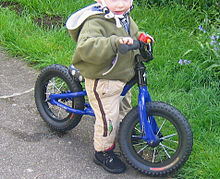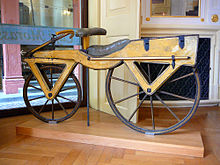Balance bicycle

A balance bicycle, run bike or no pedal bike or dandy horse is a training bicycle that helps children learn balance and steering. It has no foot pedals, no drivetrain, no chain, no gears, no gear shifters, no derailleurs, and no freewheel.
Designs[]

Balance bikes have been made out of both metal and wood. It can be a normal bicycle with pedals and related parts removed, or it can be purpose-built (especially for very small children, for whom normal bicycles are generally not available). Some are fitted with brakes and come with either air tires or solid foam tires.[1] Most commercially available designs have flat handlebars.[1]
To function properly, a balance bicycle must be small enough for the rider to be able to walk the bicycle while sitting comfortably in the saddle, putting both feet flat on the ground. The rider first walks the bicycle while standing over the saddle, then while sitting in the saddle. Eventually, the rider feels comfortable enough to run and "scoot" while riding the bicycle, then to lift both feet off the ground and cruise while balancing on the two wheels.
Learning method[]
Manufacturers of balance bicycles say that children can learn to bicycle faster because they learn to balance and countersteer first and then to pedal later, and that training wheels slow learning because kids become too dependent on them, acquiring bad habits.[2][3] Training wheels that prevent the bike from leaning also prevent countersteering, so that, as with a tricycle, kids learn to turn the handlebars the wrong way, which must be unlearned later.[4]
Sheldon Brown wrote that training wheels can become an obstacle to learning if they are adjusted incorrectly, because they prevent the bike from leaning if they are too low, and can inhibit braking if too much weight is taken off the rear wheel by training wheels that are too low.[5] Adjusting training wheels correctly, and raising them higher as the child's skill increases, avoids these problems.[5] Balance bikes with no brakes at all except the rider's feet might stop poorly as well, though very young children might not use brakes effectively anyway.[6] Brown recommended simply removing the pedals from a normal kid's bicycle, avoiding the extra expense of a balance bike,[5] and parents have had success with this approach.[2][7][8] USA Cycling President Derek Bouchard-Hall said in a Wall Street Journal article that balance bikes "have made training wheels obsolete."[9]
Balance bikes have also been recommended as learning aids for adults, and as useful for elderly people who have difficulty in walking.[10][11]
History[]

The first balance bicycle was the dandy horse, and was invented by Karl Drais, the earliest form of a two-wheeler - without pedals. His first reported ride from Mannheim to Rheinau (now a section of Mannheim) took place on June 12, 1817. Drais was a German inventor and invented the Laufmaschine ("running machine"), also later called the velocipede, draisine (English) or "draisienne" (French), or nicknamed, dandy horse. This incorporated the two-wheeler principle that is basic to the bicycle and motorcycle and meant the beginning of mechanized personal transport. In 1997, German designer Rolf Mertens developed the first commercially produced Laufrad "running bike" called LIKEaBIKE.
See also[]
- Dandy horse, a 19th Century precursor of the bicycle with no pedals
- Jyrobike
- Kick bike
- Outline of cycling
References[]
- ^ a b "Balance Bikes: How to Choose". www.twowheelingtots.com. August 8, 2019. Retrieved 2018-11-27.
- ^ a b Athavaley, Anjali (1 September 2010), "Look Ma, No Pedals! --- Ditch the Training Wheels, New Bikes Promise a Faster Way to Learn", The Wall Street Journal, New York, NY, p. D.1
- ^ Kolpack, Dave (7 June 2010), "South Dakota man sells training bikes for tykes", Bloomberg BusinessWeek, retrieved 2011-06-07
- ^ Heine, Jan (February 2011), "Cornering on a Bicycle; Master centrifugal force on curves" (PDF), Adventure Cyclist, Adventure Cycling Association, retrieved 2018-07-03
- ^ a b c Brown, Sheldon (3 May 2010), Teaching Kids To Ride, retrieved 2011-06-07
- ^ McLean, Catherine (22 May 2011), "Look ma, no pedals! Balance bikes hit Canada", The Globe and Mail, retrieved 2011-06-07
- ^ Juedes, Joy (26 July 2010), "Two-wheel training", Redlands Daily Facts, Redlands, California
- ^ Edwards, Drew (21 May 2011), "Putting the brakes on a parenting effort", Guelph Mercury, retrieved 2011-06-07
- ^ Gay, Jason (2017-05-25). "Welcome to the Tour de France of Toddler Racing". Wall Street Journal. ISSN 0099-9660. Retrieved 2017-12-04.
- ^ Mourits, Tamara (6 April 2018). "Achter de geraniums vandaan? Pak de loopfiets". Algemeen Dagblad (in Dutch). Retrieved 3 July 2021.
- ^ Gollin, Rob (24 February 2014). "Een cool alternatief voor de rollator". De Volkskrant (in Dutch). Retrieved 3 July 2021 – via imdi-sprint.nl.
| Wikimedia Commons has media related to Balance bicycles. |
- Physical activity and dexterity toys
- Road cycles
- Educational toys